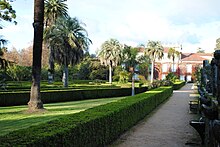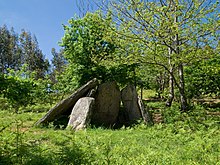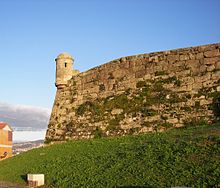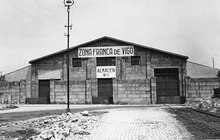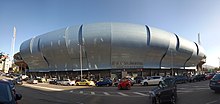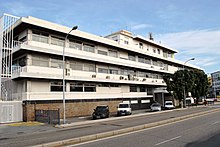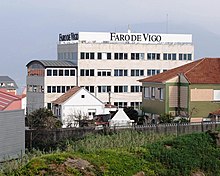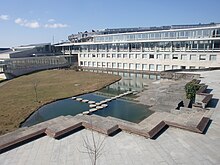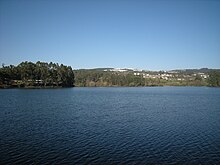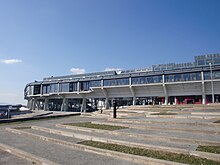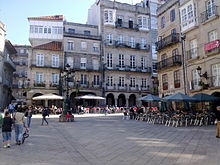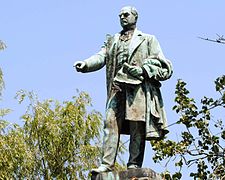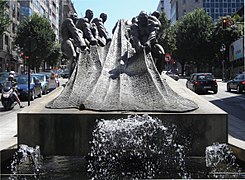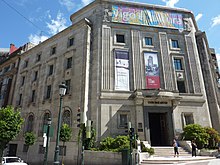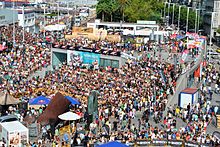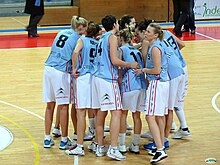Vigo
Vigo is a municipality and a city of Spain located in the province of Pontevedra, autonomous community of Galicia. With a population of 0Wrong expression: punctuation character "&" unknown..Wrong expression: punctuation character "&" unknown.293,837 inhabitants (INE 2021), it is the most populous municipality in Galicia and the fourteenth in Spain, as well as the largest city in the country without the rank of provincial capital. In addition, It is the most densely populated urban area of the conurbation formed by the set of localities that are located along 300 km of the Rías Bajas and the center of a metropolitan area encompasses another 13 municipalities with a total of 481,194 registered inhabitants. Data from the Statistical Atlas of Urban Areas in Spain published by the Ministry of Transport, Mobility and Urban Agenda estimate that the Vigo-Pontevedra urban functional area makes up the twelfth metropolitan area in Spain.
Geographically it is located in the northwest of the Iberian Peninsula, limiting only about 33 km to the north of the border with Portugal. The municipal area covers an area of 109.06 km² and its population density is 2,686.47 inhab/km².
Its economy and that of the rest of the region is characterized by the preponderance of its diversification. Its main economic drivers are the automotive industry, shipbuilding, industrial fishing and the activities of the port and free zone. Other important base sectors They are trade, services and tourism; the latter due to its beaches, cultural offer, festivals or local festivities and the Camino de Santiago on its Portuguese route along the coast.
It houses various institutions and organizations, such as Afundación, the European Fisheries Control Agency, the Fishing Shipowners Cooperative of the Port of Vigo, the Camões Institute, the headquarters of the Islas Atlánticas de Galicia or the University of Vigo, among others. This concentration of companies and institutions from various economic sectors means that nearly 500,000 people live, work or study in Vigo every day, representing approximately 53% of the population of the province and 18.46% of the population of Galicia.. The asteroid (127870) Vigo was named in honor of the city.
Toponymy
There are various theories about the origin of the place name “Vigo”. The most widespread version is that it derives from the Latin word "Vicus", which means town or farmhouse and alludes to the small Roman settlement of Vico Spacorum. Other lines of research, by archaeologists and associations, indicate that Vigo was the Roman city of Burbida Magna, which was an important commercial port and with salting industries; however, this hypothesis does not have a consensus among historians. Other theories point out that the place name of Vigo comes from the Viking word "Úig", which means bay.
Symbols
- Shield
The current shield derives from the old one that adorned the old Neptune fountain, which was located in the past in the Puerta del Sol. It symbolizes a castle with a square base and finished in a tower, next to the castle is the old olive tree that It was located in the atrium of the co-cathedral of Santa María, all on an island on a sea of five wavy stripes representing the maritime character of Vigo.
- Flag
According to some hypotheses about the origin of the flag, it is that it was used during the Reconquest of Vigo, in the Spanish War of Independence. Later, in the 1930s, it began to be used as the flag of the Maritime Province of Vigo and on April 7, 1987, the full council approved its use as the official flag. It consists of two colors, white and red and they go in the form of a sotuer: white on the sides and red above and below.
- Olive of Vigo
In ancient times Vigo was known as the "city of the olive" and nowadays as the "olive city". This nickname is due to the fact that in the atrium of the co-cathedral of Santa María there was once a large olive tree planted by the Knights Templar monks during the time when they were in charge of governing the parishioners.
The tree disappeared from that location when the current church was built. When it was demolished, the then administrator of the Vigo customs office, Manuel Ángel Pereira, collected one of its branches and planted it in the garden of his house, which was located in what is now Puerta del Sol. The tree grew until the development of the city forced it to be moved to Paseo de Alfonso XII, where it is currently located.
In its new location and to protect it, an iron fence was installed, where in August 1932 a bronze plaque was placed with the following text written:
DENTRO DE ESTA VERJA, OFRENDA DE LOS VIGUES TO YOUR SIMBóLICO RBOL, TODAY DEPOSITADA BY THE PROMESES OF YOUR LOVE, OF YOUR LEALTAD AND OF YOUR ABNEGATION BY THE AMERICATED CITY. 14-AGOSTO-1932.
Geography
Vigo is located in the western part of the Province of Pontevedra, of which it forms part as a coastal municipality of the Rías Bajas, and which is bordered to the north by the Ría de Vigo, to the northeast by the municipality of Redondela, and to the east with that of Mos, to the south with the municipalities of Porriño and Gondomar and to the southwest with that of Nigrán. On the other side of the estuary, just in front of the city are the towns of Cangas and Moaña, 5 and 3.6 km away, respectively. It is located in the historic region of Valle del Fragoso, whose lands are currently occupied by the municipality of Vigo, which is also part of the Region of Vigo, along with ten other municipalities in its metropolitan area.
The city of Vigo extends in a northeast-southwest direction on the southern shore of the estuary of the same name, at the foot of the hill called Monte del Castro, which it ended up completely surrounding due to urban growth.
The municipal area occupies the entire Fragoso valley, an old agrarian plain today transformed into a peri-urban zone, vertebrated by the Lagares River and enclosed by the foothills of Mount Penide, Mount Cela, the Fragoselo mountains and the Sierra de Galiñeiro, where the maximum altitude of Vigo is reached (Pico do Galiñeiro, 690 meters). It is therefore a wide basin or valley bordered by mountains and mountains of medium height and a narrow strip of coastline 20 kilometers long. The primitive city occupied the terraces that ran down the north and west slopes of Monte del Castro to the sea, but the enormous demographic growth experienced by the city during the century XX caused the urban core to grow towards the valley and along the coastal border.
| Northwest: Ría de Vigo | North: Ría de Vigo | Northeast: Round it |
| West: Ría de Vigo |  | This: Mos |
| Southwest: Nigran and Gondomar | South: Gondomar and Porriño | Sureste: Mos |
Climate
According to the Köppen climate classification, its climate is in transition between the Mediterranean oceanic climate (Csb) and the oceanic climate (Cfb), tending more towards the former. According to the data provided by the reports of the State Meteorological Agency, with an average of 130 rainy days per year and with a collected amount of 1,800 liters, Vigo would be, together with San Sebastián, the Spanish city where it rains the most, both having practically identical rainy days per year. However, as with temperature measurements, these data are collected by the Peinador weather station, where rainfall is 33% higher than in the urban area.
The temperatures shown in the table below, belonging to the Vigo Airport weather station, do not reflect the reality of the city's climate, which is much more benevolent. Although the measurements are true and taken within the municipal area from Vigo, they were taken at an altitude of 264 meters and 10 kilometers from the center, at the airport, in an area where the climate is colder than in the city and where fog is quite frequent.
| Month | Ene. | Feb. | Mar. | Open up. | May. | Jun. | Jul. | Ago. | Sep. | Oct. | Nov. | Dec. | Annual |
|---|---|---|---|---|---|---|---|---|---|---|---|---|---|
| Temp. max. abs. (°C) | 21.8 | 27.6 | 28.1 | 29.6 | 33.6 | 38.6 | 39.7 | 40.8 | 36.9 | 32.6 | 24.6 | 23.2 | 40.8 |
| Average temperature (°C) | 12.2 | 13.6 | 16.0 | 17.2 | 19.8 | 22.7 | 24.9 | 25.2 | 23.3 | 19.4 | 14.9 | 12.6 | 18.5 |
| Average temperature (°C) | 9.0 | 9.7 | 11.8 | 13.0 | 15.3 | 18.0 | 19.9 | 20.2 | 18.6 | 15.5 | 11.6 | 9.6 | 14.4 |
| Temp. medium (°C) | 5.8 | 5.9 | 7.5 | 8.6 | 10.8 | 13.3 | 14.9 | 15.1 | 13.8 | 11.5 | 8.2 | 6.5 | 10.2 |
| Temp. min. abs. (°C) | -4.0 | -5.0 | -3.0 | -0.2 | 2.0 | 4.6 | 7.6 | 7.2 | 5.0 | 1.0 | -0.8 | -3.4 | -5.0 |
| Total precipitation (mm) | 222.6 | 144.5 | 153.6 | 150.2 | 113.1 | 56.6 | 40.1 | 48.5 | 93.7 | 212.6 | 243.7 | 234.8 | 1714 |
| Precipitation days (≥ 1 mm) | 14.5 | 11.5 | 12.3 | 13.0 | 10.8 | 6.7 | 4.9 | 5.2 | 7.9 | 12.7 | 14.1 | 14.7 | 128.3 |
| Hours of sun | 135 | 153 | 197 | 212 | 251 | 276 | 311 | 294 | 228 | 173 | 133 | 127 | 2490 |
| Source: State Meteorology Agency | |||||||||||||
Natural spaces
Beaches
On the coast of Vigo there are 47 coves and beaches, among them are sandbanks with waves for the practice of water sports, wild coves, family beaches, nudist beaches and urban beaches. Some of these coves and beaches have various facilities or services for their users, such as sports areas, showers, footbaths, public address system, promenade, Red Cross surveillance and rescue post, areas adapted for people with disabilities, etc. In May 2022, the Association for Environmental and Consumer Education (ADEAC) awarded the blue flag distinction to 11 beaches in the municipality.
These are the 38 beaches and coves in Vigo, not counting the 9 located on the Cíes Islands:
- In the parish of Alcabre you will find the beaches of Argazada, Carril, Cocho, Cocho das Dornas, Espedrigada, Fontes, Fontoura, Mourisca, Santa Baia and Tombo do Gato.
- In the neighborhood of Bouzas is located the Playa del Adro.
- In the parish of Corujo you will find the beaches of Baluarte, Calzoa, Fechiño, Fontaíña, Vao and Foz, the latter shared with the parish of Navia.
- In the parish of Navia you will find the beaches of Samil and Foz, the latter shared with the parish of Corujo.
- In the parish of Oya are located the beaches of Buraca, Cala da Furna, Canido, Canto da Area, Serral, Sobreira, Toralla and Xunqueiro.
- In the parish of Sayanes you will find the beaches of Muíños de Fortiñón, Noiva and Portiño.
- In the parish of Teis you will find the beaches of Calo del Faro, Fábrica, Lagoa, Manquiña, Mende, Punta, Rios de dentro, Rios de Outside and Suacasa.
- Isle Beaches
The other 9 beaches in Vigo are located in the Cíes Islands archipelago, which belongs to the Islas Atlánticas de Galicia National Park. These arenas are the following: Areiña, Bolos, Cantareira, Figueiras, Margaridas, Muxieiro, Our Lady of Carracido, Rodas and San Martiño.
Parks and gardens
More than a dozen public gardens and urban parks are distributed throughout the municipal area, with an approximate average of 4.5 m² of green space per inhabitant. The predominant tree species in these green areas are typical of the Galician mountains (eucalyptus, pine or oak), likewise they also contain plant specimens from other areas and naturally adapted to Vigo. These parks have various facilities or services, such as: sculptures, ponds, ornamental fountains, viewpoints, exercise parks, playgrounds, sports areas and walking areas.
However, the largest urban park in Vigo and the city's main green lung is the Castrelos park, located in the homonymous parish, declared an Asset of Cultural Interest and Historical Garden. Relatively close to this park and also nestled within the urban area of the olive city, are the Elduayen gardens in the port area, the Monte del Castro that occupies the space of a castro town and in its highest part are the remains of the 16th century fortress, the La Bouza park in Coya, the Camilo José Cela park that connects Torrecedeira street with Pi y Margall, and the Alameda park in Compostela square, the first urban park created in vigo.
The botanical heritage of the municipality is completed by three other parks located on the outskirts. The Fundación Sales botanical garden -the only botanical garden in Vigo-, the A Guía mountain and the Riouxa park.
Forest parks
Twelve forest parks are located on the hills surrounding the urban center of Vigo, occupying a total area of 705,460 m². The conservation and maintenance of each of these enclosures is in charge of the corresponding forestry community. They have various facilities for their users, such as barbecues, bars, running circuits, fountains, tables, viewpoints, playgrounds, camping areas, picnic areas, etc.
These parks are the following: Beade Forest Park, Becerreira-Bandeira Forest Park, Bembrive Forest Park, Corujo Forest Park, Guieira Forest Park, Monte Alba-Cepudo Forest Park, Monte de Los Pozos, San Miguel de Oya Forest Park, Sayanes Forest Park, Teis Forest Park, Vixiador-Candeán Forest Park and Zamanes Forest Park.
Vigozoo
The Natural Park of Sciences-Vigozoo is located on Mount Madroa, in the parish of Teis.
This zoological park covers an area of 55,646 m², where more than 125 different animal species are exhibited in naturalized enclosures adapted to each species based on their characteristics. In these facilities there are mammals and birds from places like America, Africa, Europe and Oceania, as well as more than 50 species of insects, arachnids, amphibians and reptiles, the latter located mostly in the building called Exotarium.
Hiking
The approved hiking route called GR-53 (Panoramic Path of Vigo) connects 11 of the 12 forest parks located in various parts of the municipal area. Other well-known routes apart from the aforementioned, are the GR-58 path (the path of the Greas), the route of the road to Beiramar, the path between lighthouses in the Cíes Islands, or the coastal path and the A Guía mountain in you. These last three mentioned routes were awarded in 2021 with the distinction of blue trail by the Association for Environmental and Consumer Education (ADEAC).
Fauna and flora
- Fauna
The territory of Vigo presents a great biodiversity, in the municipal term the more or less stable presence of approximately a hundred bird species has been detected that have adopted the environment as a residence or as a place of habitual passage. These can be divided into two large groups. In the first place, waterfowl such as the mallard, the shag, the egret, the heron, the seagull or some specimen of kingfisher. In second place, there are columbiform and passerine birds, such as the crow, the starling, the sparrow, the blackbird, the dove or the magpie. Finally, the presence of other types of species such as the griffon vulture, the tawny owl, the peregrine falcon or the woodpecker is also noteworthy.
Regarding the amphibians, mammals, and reptiles that can be found in the municipality, the existence of species such as the common squirrel, the weasel, the rabbit, the hedgehog, the marten, and the common, the wild boar, the ocellated lizard, the Dartford salamander, the common toad, the badger, the newt, the Seoane's viper or the fox.
Occasionally you can see cetaceans such as arroaces, pilot whales or bottlenose dolphins that come close to the coast and beaches.
- Flora
The urban center has almost 11,000 ornamental trees in avenues, streets and squares, this figure does not include species in green areas or forest parks. Among the tree species found within the urban area, the following can be cited:
- Aligustre on Sanjurjo Badía Street.
- Arce on the avenue of García Barbón and on the streets Barcelona, Florida, Gran Vía, Zamora and Zaragoza.
- Camelio in the center of the city and in the avenue of García Barbón.
- Castaño de indias en la avenida de García Barbón.
- Camelia japónica in the center of the city, on the avenue of the Camelias and on the streets Coruña, Estrada, Marquis de Valladares, Recula and Toledo.
- False pimentero on Vigo's journey.
- Fotinia on Mayor Portanet Avenue.
- Lagunaria on Ramon Nieto Avenue.
- A bitter orange in the avenue of García Barbón and in the streets Tomás Alonso and Travesía de Vigo.
- Olivo on the avenue of Mayor Portanet and on the streets Alfonso XII and Rosalía de Castro.
- Peral on Garcia Barbon Avenue.
- Plátano de sombra in practically all the parks and gardens of the city, in the avenues Attlántida, García Barbón, Marina Española and La Paz.
- Syria rose on Garcia Barbon Avenue.
On the other hand, the main tree species that can be found in the mountains that border the urban area are those typical of the Galician coastal forest, in these natural spaces chestnut, eucalyptus, pine and oak trees abound.
- Fauna and flora in the Isles
Apart from the fauna and flora existing in the city and its periphery, it should be noted that the Cíes Islands archipelago has great biodiversity. The islands have significant environmental wealth, both terrestrial and marine, and a great variety of animal and plant species coexist on them.
The Cíes Islands offer their own ecosystems in which a very diverse vegetation sprouts, they are home to various populations of seabirds and since 1988 they have been included in ZEPA (Special Protection Zone for Birds) areas. Species also inhabit the archipelago. non-marine birds and other classes of vertebrates, especially small mammals and reptiles.
Environmental disasters
- Black Marea of Janina Oil
In 1957, the first maritime catastrophe occurred that ecologically damaged the coast of Vigo. On January 18 of that year, a fire broke out on board the oil tanker Janina while it was sailing along the Portuguese coast, the accident caused an oil slick of approximately 10,000 tons of crude that particularly affected the southern area of the estuary.
- Black Marea of Yanxilas Oil
In 1965, eight years after the Janina incident, the oil slick caused by the Yanxilas oil tanker took place. That it occurred due to an accident suffered on board the ship that occurred while it was sailing a few miles from the Ría de Vigo. The spill of approximately 16,000 tons of crude seriously affected the coast of Vigo and its natural environment.
- Black oil company Polycommander
On May 5, 1970, the ship Polycommander during its passage through the Cíes Islands ran aground on some shoals near the island of Monteagudo, which caused the reefs to tear the ship's hull on its port side. This event caused a fire and a slick of 15,000 tons of crude oil that mainly affected the coast of Vigo and other nearby towns such as Bayona, Cangas or Nigrán. The spectacularity of the accident was on the cover of The New Yorker magazine in May 1973.
- Black Marea of the Prestige Oil
The last maritime disaster that affected Vigo occurred in 2002, on November 13 of that year the oil slick caused by the sinking of the Prestige reached its shores. The damage in the estuary was not as severe as in other areas of the Galician coast, since the National Park of the Atlantic Islands formed a natural barrier that stopped the entry of fuel into the Rías Bajas. Despite this, the Cíes were affected by tar in 30% of its coastal strip, where the cleanup work lasted for months due to the amount of spillage.
- Forest fires October 2017
On October 15, 2017, Vigo and other nearby municipalities were affected by numerous forest fires. On that day, strong winds and high temperatures were recorded due to Hurricane Ophelia passing through Galicia, which contributed to fan the flames and spread the fires. These fires mainly affected peri-urban parishes and their mountains, even declaring outbreaks in areas of the urban area. Given the collapse of the extinguishing means, the residents collaborated in the extinction tasks with the aim of preventing the flames from approaching the inhabited nuclei.
History
Prehistory
Vigo and its region have been populated since ancient times, as witnessed by the large number of dolmens and mámoas that have been found in various parts of the municipal area. Although, however, as far as the Paleolithic is concerned, the only finds dated to the Stone Age are fifty or so tools carved in quartz and quartzite.
Regarding the Neolithic period, the funerary constructions, called burial mounds, dated between 3000 and 1800 BC, stand out. C., among which stands out the so-called Casa dos Mouros, located in the parish of Candeán. In turn, outstanding petroglyphs are those found in Fragoselo and Millaradas.
In the transition from the 3rd to the 2nd millennium B.C. C., there is a large set of rock engravings with representations of geometric motifs, weapons and fauna. Several ceramic finds, bronze weapons and more cave engravings also indicate the existence of inhabitants in the county during the Bronze Age, between 1,900 and 800 BC. c.
The castro culture, which spans the Iron Age and developed in Galicia from the VIII century a. C. until the end of I d. C., left various vestiges in the municipality as verified by the remains of twenty-six castreño towns. This indicates that during this period the area had one of the highest population densities in Galicia. The largest of these towns is the one located on the west slope of Monte del Castro. The inhabitants of these communities lived from agriculture, an activity that they complemented with hunting and fishing.
Roman times
During Roman times, there was evidence of intense commercial and port activity on the coast of Vigo since the II century to. C. up to the I century d. C., period in which the so-called Pax Romana was established. Likewise, excavations carried out in the Arenal and in the historic quarter reveal the possible existence between the centuries III and VI d. C. of an important Roman settlement in these areas.
Since Lugo is the Galician town with the largest number of Roman archaeological remains, in some places in the municipality vestiges of the Romanization process are still preserved, such as streets, salting factories, port facilities, necropolises, underwater remains or villas Romans scattered along the coast (Alcabre, Toralla, etc.).
According to the legends of the Roman chronicles, on August 24, 60 B.C. C., Julio César in one of his persecutions of a Lusitanian warrior tribe in their fight against the Herminios arrived at the Cíes Islands archipelago, where the military leader spent a few days off.
Middle Ages
The information available about this period in Vigo is very scarce, especially during the Early Middle Ages. It was a period in which the Germanic incursions and pirate attacks from northern Europe made the population move inland in search of more security, and take refuge in Monte del Castro.
With the spread of Christianity during the Middle Ages, the Church dominated Galician society, so Vigo depended on the Cistercian monastery of Melón (Orense).
There is documented evidence of the existence of Romanesque churches from the year 1024 in the current municipal term that prove the existence of population settlements in the area during the centuries XI, XII and XIII, in locations coinciding with the current parishes. Only three temples remain from this period: Santiago de Bembrive, Santa María de Castrelos and San Salvador de Corujo. Two bridges also survive in Castrelos and Sárdoma, as well as the remains of the Freixo hermitage in Valladares and the Baroque churches. of Lavadores and Sárdoma.
From the XII century, Vigo began to recover its population. During this time the parish of Santiago de Vigo was the most important in the town together with the neighborhood of Santa María. Despite this, the economic development of Vigo was limited because the crown granted Bayonne the power to trade by sea with other cities, to the detriment of the first.
On the other hand, within this period the Cantigas de Amigo composed by Martin Codax from Vigo stand out.
15th to 18th centuries
Despite incessant pirate attacks over the centuries, the city continues to grow. The craft and trade activities gain importance within this stage, although the most important activity is made up of sardine fishing.
In 1585 the English corsair Francis Drake tried to take the town, but failed thanks to the opposition of the neighbors. However, four years later he successfully attacks Vigo again, razing and burning everything in his path.
Later, in 1617 Turkish pirates tried to assault the city but this attack was repelled again by the residents. The frequent maritime attacks forced the construction in 1656 of the city walls and the Castle of San Sebastián.
In 1702 an outstanding historical episode took place in the history of Vigo, the one known as the Battle of Rande. The Anglo-Dutch fleet pursued the Spanish La Plata fleet and the French warships inside the estuary. they escorted This fleet laden with riches from America is destroyed after a fierce battle developed both at sea and on land. The English took several ships loaded with treasures from the Indies, while the rest were sunk by flames and are still at the bottom of the Ensenada de San Simón, inside the estuary. In commemoration of this battle, in London it is located Vigo Street.
Years later, in 1719, the capture of Vigo took place. This attack occurred in the course of the Quadruple Alliance War and was designed in retaliation for Spanish support for the Jacobite rising in Scotland, which ended in the defeat of Philip V's troops at the Battle of Glenshiel. After the capture of the town, Lord Cobham's troops began looting it. They seized a large quantity of weapons and ammunition, which they suspected were being stored for a future invasion of England.
In 1778, Carlos III broke with the monopoly of the ports authorized to trade with America, so that Vigo began to benefit from high-board traffic. At this time the town of Vigo was completely surrounded by a wall, built on the occasion of the Portuguese Restoration War, fearing an invasion. Near the sea was the bastion of Laxe and on the opposite side, the Castle of San Sebastián. In the walls of this fortification there were seven gates located at various strategic points: the A Laxe gate, the Berbés gate, the Gamboa gate, the Falperra gate, the Sea gate, the Placer gate and the Sol gate.
Finally, the arrival in the city of Catalan merchants and industrialists in the second half of this century meant a small economic revolution for the town, since soap, salting, and leather or linen factories proliferated.
19th century
At the beginning of the century, in 1809, as happened in the rest of Spain, Vigo was occupied by the French army. The invasion provoked a popular uprising led by Bernardo González del Valle "Cachamuíña", Juan Almeida and Pablo Morillo, this resistance ended with the expulsion of the French military on March 28 of that same year. For this fact, Fernando VII granted the town the title of "Faithful, Loyal and Valorous City", in gratitude for the actions of the neighbors during this episode of the Spanish War of Independence.
Subsequently, in the 1830s, the royal road leading to Madrid, known as the Castilla or Villacastín highway, was prepared and the reconstruction works of the new Collegiate Church, designed by Melchor de Prado, were completed.
The second half of this century marked a period of growth for the city, partly fostered by the increase in relations with America, favored by the strategic position of the Port of Vigo in the Atlantic. Thus, since 1855 regular maritime communication services have been established with Buenos Aires, Havana and Puerto Rico. In addition, in these years the branch of the Bank of Spain was also created and a new stone pier was built. This growth of the city caused its councilors to agree to demolish the walls to facilitate its expansion.
A decade later, the construction of the railway and the filling works of the estuary began in order to expand the port facilities. In the following years, factories for derivatives of marine and salted products continued to open in Vigo, which meant a growth in the salaried population and the bourgeoisie. The city expands beyond the walls with the opening of new streets and the construction of noble stone buildings. On the other hand, in 1880 the Municipal Savings Bank of Vigo would be created and in 1881 the Vigo-Orense railway line was inaugurated. In that decade, on May 17, 1863, the Compañel printing press published Cantares Gallegos by Rosalía de Castro, work that marked the beginning of the literary movement known as Rexurdimento.
In 1878 Jules Verne made his first visit to the city on his yacht Saint Michel III, the second was in 1884, the purpose of this visit by the writer was to see the Ensenada de San Simón, the setting of the Battle of Rande and that Verne himself had immortalized with the Nautilus in a chapter of his work 20,000 Leagues Under the Sea.
At the end of this century, in 1898, the Port of Vigo received badly wounded soldiers from the war in Cuba, welcoming them and providing them with the necessary help. This fact gave Vigo the title of "Always Beneficent", so since then the city's coat of arms has kept the motto "Faithful, Loyal, Valorous and Always Beneficent City".
20th century
This century marked a stage of astonishing economic progress, in its first decades the liberal bourgeoisie from Vigo took the mechanisms of economic and political power into their hands. In little more than ten years the population doubled (in 1910 it already reached 30,000 inhabitants). In addition, as the century progressed, Vigo absorbed the neighboring municipalities of Bouzas (1904) and Lavadores (1940).
During the first third of the XX century, the port of Vigo was inextricably linked to the image of thousands of Galicians who embarked heading to America. Emigration was largely motivated by the economic crisis suffered by many families, and the port of Vigo was one of the main starting points for this migratory flow. Another symbol of the time is the tram, which began operating in 1914. During this period in the city there was intense social activity. Thus, there were many newspapers and weeklies, associations and organizations of a political or trade union nature.
The Civil War was hardly noticeable in the city, where there was hardly any opposition to the coup d'état of July 18, 1936 and only the Battle of Vigo took place, which lasted from July 18 to 28. This was not the case. in Lavadores, where there was more resistance. However, the absence of struggle did not free Vigo from a harsh repression, among the victims were the mayor Emilio Martínez Garrido, artists, intellectuals, trade unionists or politicians related to the Popular Front, such as deputies Antonio Bilbatúa, Heraclio Botana or Ignacio Seoane.
In later years the port served as a fuel and food supply base for ships of the Third Reich. Another of the Nazi activities in Vigo was the export of tungsten from the Rande loading dock to Germany and other Axis countries.
At the end of the 1950s, the so-called Spanish economic miracle began, a phenomenon that produced a great demographic growth in Vigo and other nearby towns. The growing job offer at that time attracted a large population from rural areas, mainly from the Province of Ourense, which took root in neighborhoods such as Teis. In addition, during developmentalism, new residential neighborhoods such as Coya were created. This demographic growth was thanks to the consolidation in the city of various industries, such as Citroën Hispania, the automotive auxiliary industry, the Empresas Álvarez ceramic factory, the ASCON, Barreras or Vulcano shipyards, and fishing industries such as Motopesqueros de Altura Reunidos. (M.A.R.) and Pescanova.
In the 1960s and 1970s, the communications network with the rest of the peninsula was improved and new plans were created to expand the city. Later, in the last years of the Franco regime and during the first years of the transition, with Joaquín García Picher in the mayor's office, a branch of the tax agency was opened in the city, the new university college and the Eiras reservoir in Fornelos de Montes were built., Vigo is also designated as one of the venues for the future 1982 Soccer World Cup. Within this period, in 1979, the Órbigo river accident occurred, in which 45 students and 3 teachers of a school died. Vigo school, this sinister shocked the local society of the time being the day of greatest mourning in the recent history of Vigo.
The growth of previous years was slowed down during the decade 1975-1985 due to the impact produced by the industrial reconversion of the naval sector that hit the city hard, causing an increase in social conflicts and destroying part of the industrial fabric traditional linked to the sea. At the end of the century, Vigo shows an economic recovery compared to the previous decade, partly thanks to the creation of estates and institutions such as Caixanova, IFEVI or the University.
21st century
In the year 2000 the population of the municipality was around 280,000 inhabitants and it was located in the center of an area of influence of 500,000. This demographic growth was maintained in Vigo and in other towns in its area of influence until 2012, year in which 297,335 inhabitants are reached. This increase in the population is mainly due to the good moment experienced by the main economic activities of the city in the first decade of this century. This demographic growth was slowed down in subsequent years as a result of the economic crisis that affected Spain.
During the 2010-2020 decade, various actions took place that entailed an urban transformation of the urban area, such as: construction of sports infrastructures, creation of green areas, humanization and pedestrianization of avenues and streets, installation of elevators and stairs mechanics in the center of the city, or the rehabilitation of buildings and public spaces.
In 2021, a study carried out by the Organization of Consumers and Users on the 15 large cities of the country, designates Vigo as the "Spanish city with the highest quality of life".
Population
During the XX century, Vigo was the European city with the highest demographic growth, multiplying its population by 12, passing from having 23,259 inhabitants in 1900, to 285,526 registered at the end of the century. The XXI century began with a balance uninterrupted positive vegetative growth in the first decade, but the population increase slowed down during the five-year period that spanned from 2011 to 2015, this demographic decline coinciding with the economic crisis that affected Spain. It was not until 2016 when a sustained upward trend in the population was recovered.
With 293,837 inhabitants as of January 1, 2022, according to INE data, Vigo is the most populous municipality in the autonomous community of Galicia. According to the population register, 138,634 people are men (47.18%) and 155,203 women (52.82%). This small difference in the male-female ratio in favor of women occurs in the age ranges above 30 years, and increases more evidently after 70 years according to the population pyramid.
| Graphic of demographic evolution of Vigo between 1842 and 2021 |
 |
Rule population (1842-1897, except 1857 and 1860 which is a de facto population) according to population censuses of the centuryXIX.Population of law (1900-1991) or resident population (2001-2011) according to population censuses of the INE.Population according to the municipal register of 2021 of the INE.Note: between the census of 1910 and the previous one grows the term of the municipality because it incorporates Bouzas, while in the 1950 it is already included Lavadores. |
Metropolitan Area
The metropolitan area extends throughout the south of the province. It is bordered to the southeast by the Condado-Paradanta Region, to the south by Bajo Miño and Portugal, to the north by the Ría de Vigo, the Morrazo Region and the Pontevedra Region, while to the west it borders the Atlantic Ocean.
According to the data provided by the INE as of January 1, 2022, it has a population of 481,194 inhabitants, of which 293,837 inhabitants live in the municipality of Vigo, which means 61.06% of the total of the population of the metropolitan entity.
Currently, the metropolitan area of Vigo is made up of the following municipalities: Baiona, Cangas de Morrazo, Fornelos de Montes, Gondomar, Moaña, Mos, Nigrán, Pazos de Borbén, Porriño, Redondela, Salceda de Caselas, Salvatierra de Miño, Sotomayor and Vigo.
Foreign population
21,143 citizens with a nationality other than Spanish reside in Vigo according to provisional data from the municipal register as of January 1, 2022.
The largest foreign colony in the municipality, with 2,791 inhabitants, is that of citizens of Venezuela, in second place are the citizens of Portugal with 2,122 registered inhabitants, and in third place with a total of 2,069 inhabitants are citizens Colombians.
Most of the population with a foreign passport in Vigo is concentrated in the districts belonging to the urban center (1, 2 and 3), in the 7th district (Calvario neighborhood and Cabral, Candeán and Lavadores parishes) and in the Bouzas-Coya axis (district 4). While the presence of foreign citizens in the peri-urban parishes of the municipality is less than other areas, being in some cases very small, as is the case of district 8 (Beade, Bembrive, Matamá, Valladares and Zamanes).
Administration and politics
Public Institutions
In Vigo there are four levels of public administrations, which have different responsibilities and powers. On the one hand, there is the City Council of Vigo, it is the body with the greatest powers and public officials in the city, since it regulates the daily life of citizens, and important issues such as urban planning, transport, the collection of municipal taxes, the management of road safety through the local police, maintenance of public roads (paving, cleaning, etc.) and gardens. It is also responsible for the construction of facilities such as libraries, nurseries, sports centers, among others.
The Pontevedra Provincial Council has an office in the city, on Eduardo Chao street. This is the public body with the least powers in Vigo.
The administration in charge of the autonomous government of Galicia is the Junta de Galicia, which has a territorial delegation in Vigo located in Plaza de la Estrella and its own delegate. The Board has broad powers over the management of the city, from social affairs, commerce, education, economic policies, traffic, etc. It is also responsible for the construction of facilities such as schools, hospitals, courts, residences for the elderly, universities, etc.
Since Vigo has its own treatment in the provision of public services similar to those of a provincial capital by the state administration, in the city there are offices of the General State Administration that deal with airport management, coasts, railways, justice, security (army and national police) and ports, among other powers. These are coordinated by the government delegate in Galicia and by the provincial sub-delegate. Among the institutions representing the Government of Spain installed in Vigo, are the Tax Agency, General Directorate of Traffic, Commercial Courts, Property and Commercial Registry, Government Sub-delegation or General Treasury of Social Security.
Municipal government
The current mayor is Abel Caballero, from the Partido dos Socialistas de Galicia-PSOE, elected for the fourth consecutive time as alderman in the 2019 municipal elections. In the city council, the seats are distributed as follows: PSdeG-PSOE: 20, PPdG: 4, Marea de Vigo: 2 and BNG: 1.
Since the recovery of democracy in Spain, eleven municipal elections have been held and only three parties have governed the city: the PSdeG-PSOE, the PPdG and the BNG. From the first municipal elections of 1979 to 1995, the PSdeG-PSOE governed the city, during this period there were two mayors: Manuel Soto Ferreiro (1979-1991) and Carlos González Príncipe (1991-1995). In the 1995 elections, the PPdG candidacy led by Manuel Pérez Álvarez achieved an absolute majority and governed Vigo until 1999. From that year until 2007, three mayors from three different parties (BNG, PSdeG- PSOE and PPdG). In the 2007 elections, Abel Caballero was elected mayor, forming a government in coalition with the BNG. In the last municipal elections held, 2011, 2015 and 2019, Abel Caballero was re-elected mayor in the three electoral appointments, obtaining in the last two the second and the third absolute majority in the history of Vigo.
| Period | Name | Party |
|---|---|---|
| 1979-1983 | Manuel Soto Ferreiro | Partido dos Socialistas de Galicia (PSdeG-PSOE) |
| 1983-1987 | Manuel Soto Ferreiro | Partido dos Socialistas de Galicia (PSdeG-PSOE) |
| 1987-1991 | Manuel Soto Ferreiro | Partido dos Socialistas de Galicia (PSdeG-PSOE) |
| 1991-1995 | Carlos González Príncipe | Partido dos Socialistas de Galicia (PSdeG-PSOE) |
| 1995-1999 | Manuel Pérez Álvarez | Popular Party of Galicia (PPdeG) |
| 1999-2003 | Lois Pérez Castrillo | Galego Nationalist Block (BNG) |
| 2003-2007 | Ventura Pérez Mariño (2003) Corina Porro (2003-2007) | Partido dos Socialistas de Galicia (PSdeG-PSOE) Popular Party of Galicia (PPdeG) |
| 2007-2011 | Abel Knight | Partido dos Socialistas de Galicia (PSdeG-PSOE) |
| 2011-2015 | Abel Knight | Partido dos Socialistas de Galicia (PSdeG-PSOE) |
| 2015-2019 | Abel Knight | Partido dos Socialistas de Galicia (PSdeG-PSOE) |
| 2019- | Abel Knight | Partido dos Socialistas de Galicia (PSdeG-PSOE) |
| Political party | 2019 | 2015 | 2011 | 2007 | 2003 | 1999 | 1995 | 1991 | 1987 | 1983 | 1979 | ||
|---|---|---|---|---|---|---|---|---|---|---|---|---|---|
| % | Votes | Councillors | Councillors | Councillors | Councillors | Councillors | Councillors | Councillors | Councillors | Councillors | Councillors | Councillors | |
| Partido dos Socialistas de Galicia (PSdeG-PSOE) | 67.64 | 101 058 | 20 | 17 | 11 | 9 | 8 | 7 | 8 | 11 | 11 | 12 | 8 |
| Popular Alliance (AP) - Popular Party of Galicia (PPdeG) | 13,69 | 20 460 | 4 | 7 | 13 | 13 | 10 | 11 | 15 | 13 | 9 | 11 | - |
| Marea de Vigo (MdeV) | 6.95 | 10 384 | 2 | 3 | - | - | - | - | - | - | - | - | - |
| Galego National-Popular Block (BN-PG) - Galego Nationalist Block (BNG) | 5,66 | 8461 | 1 | 0 | 3 | 5 | 7 | 8 | 4 | 1 | 0 | 0 | 1 |
| Communist Party of Galicia (PCG) - United Esquerda (EU) | - | - | - | - | 0 | 0 | 0 | 0 | 0 | 0 | 0 | 1 | 3 |
| Vigueses (PROVI) | - | - | - | - | - | - | 2 | 1 | - | - | - | - | - |
| Galego-Esquerda Galega Socialist Party (PSG-EG) | - | - | - | - | - | - | - | - | - | 2 | 5 | - | - |
| Union de Centro Democrático (UCD) - Centro Democrático y Social (CDS) | - | - | - | - | - | - | - | - | - | 0 | 2 | 0 | 9 |
| Independent | - | - | - | - | - | - | - | - | - | - | - | 3 | - |
| Democratic Coalition (CD) | - | - | - | - | - | - | - | - | - | - | - | - | 3 |
| Galega Unit (UG) | - | - | - | - | - | - | - | - | - | - | - | - | 3 |
Justice
Vigo is the seat and head of judicial district number 3 of the province, whose demarcation includes the municipalities of Vigo, Bayona, Gondomar and Nigrán. It also houses the fifth and sixth sections of the Provincial Court of Pontevedra. All these organisms are concentrated in the City of Justice.
Territorial organization
Parishes and neighborhoods
The internal division of Vigo is complex and there is no general consensus among the different administrations on its territorial organization, a common situation in most Galician town halls. According to the data provided by the INE gazetteer, the municipality It is divided into eighteen administrative parishes (which do not have to coincide with the ecclesiastical ones), the Cíes Islands and the downtown area, which de facto functions as one more administrative division despite not being considered as such according to the Galician Institute of Statistics (IGE). Likewise, the parish of Bembrive also has the rank of minor local entity and has its own village mayor.
| Parish or population nucleus | Surface (km2) | Inhabitants (2021) | Location |
|---|---|---|---|
| Alcabre (Santa Eulalia) | 1.2 | 4 276 | |
| Beade (San Estevo) | 7 | 5 252 | |
| Bembrive (Santiago) | 9 | 4 399 | |
| Cabral (Santa Mariña) | 9,1 | 6 669 | |
| Candean (San Cristovo) | 5 | 4 693 | |
| Castrelos (Santa Maria) | 2 | 7 963 | |
| Comesaña (San Andrés) | 3 | 6 509 | |
| Corujo (San Salvador) | 9 | 5 333 | |
| Freixeiro (San Tomé) | 1.05 | 5 921 | |
| CIS | 4.33 | 4 | |
| Washing machines (Santa Cristina) | 6 | 17 446 | |
| Matama (San Pedro) | 4.67 | 3 659 | |
| Navia (San Paio) | 2.45 | 6 276 | |
| Oya (San Miguel) | 4 | 3 865 | |
| Sárdoma (San Pedro) | 1.9 | 2 413 | |
| Sayanes (San Jorge) | 1,82 | 1 158 | |
| Teis (San Salvador) | 5 | 2 265 | |
| Valladares (San Andrés) | 11 | 5 413 | |
| Vigo Centro | 14,54 | 199 466 | |
| Zamanes (San Mamed) | 7 | 857 |
Apart from the previously mentioned population entities, in the past there were the now-defunct parishes of Bouzas, Coya, San Juan del Monte and San Paio.
The Galician city also has a large number of neighborhoods, historically the best known and most noteworthy are Arenal, Balaídos, Berbés, Bouzas, Calvario, Casablanca, Casco Viejo and Coya. The importance of the aforementioned neighborhoods is due to their wide population density and the large number of companies and institutions that are within them. Likewise, the parish of Chapela -although belonging to the municipality of Redondela- functions as another population center of Vigo, since all the construction is due to the geographical situation in urban continuum with Teis.
Districts
The municipality is divided into districts according to the Large Cities Law, these in turn are divided into neighborhoods or parishes. The districts of Vigo are the following:
- District 1. It is bounded by the central area of the city and the Old Town.
- District 2. It includes the neighborhood of Casablanca and Venezuela Street.
- District 3. It includes the part of the urban center that includes Beiramar, as well as the area of Naughty.
- District 4. It includes the western part of the urban center, which includes the neighborhoods of: Coya and Bouzas.
- District 5. Located south of the city centre, it comprises the parishes of Castrelos, Freixeiro and Sárdoma.
- District 6. Located east of the municipality, it comprises the parish of Teis.
- District 7. Located southeast of the municipality, it comprises the Calvary district, as well as the parishes of Cabral, Candean and Lavadores.
- District 8. Located south of the municipality, it comprises the parishes of: Beade, Bembrive, Matamá, Valladares and Zamanes.
- District 9. Located west of the municipality, it comprises the parishes of: Alcabre, Comesaña, Corujo, Navia, Sayanes and Oya.
Consular Representation
Vigo is home to various consulates of those nations with which it maintains a greater number of trade relations or the presence of immigrants from those countries in the area.
Economy
The economy of Vigo is characterized by its diversification linked above all to the industrial, fishing, services and tourism sectors. Historically it is the economic and industrial engine of Galicia, according to the Galician Institute of Statistics its annual nominal GDP is 7 759 million euros, meanwhile the municipality and the rest of its region with 10,709 million contribute 18.2% of the regional GDP.
Free zone
A very important institution for the industrial development of Vigo and its region has been the free zone, an organization based on public law that currently functions as a local development agency, promoting infrastructures and land of an eminently industrial and commercial nature..
The main objective of the Vigo Free Trade Zone is to encourage the establishment of companies with an export vocation, through the application of tax and customs exemptions. It was created by Decree Law of June 20, 1947, with the intention of taking advantage of the favorable strategic location conditions of the port of Vigo with respect to international maritime trade to promote industrial development in the region.
Industrial estates
The Vigo Free Trade Zone has six areas and industrial estates in operation, these are the Bouzas port area, the Porto do Molle business and tertiary park in Nigrán, the Vigo Technology and Logistics Park, the Balaídos industrial estate, the A Granxa industrial estate in Porriño and the Salvaterra-As Neves Logistics Platform (PLISAN). The activity of these parks accounts for 33% of the gross value added (VAB) of the Vigo Region, generating around 18,000 direct jobs and 40,000 indirect ones.
Apart from the polygons mentioned above and integrated into the public institution, in Vigo and other municipalities in its conurbation there are more than fifteen industrial areas and business parks that house companies from different economic sectors.
Automotive industry
One of the most important activities in the local economy is the automobile industry, headed by Stellantis Vigo. The factory employs more than 6,500 direct workers and 88% of its production is shipped outside of Spain, representing around 30% of total Galician exports abroad.
The plant has drawing, assembly, painting and welding workshops at its facilities in Balaídos. It currently produces the following models: Citroën Berlingo III and ë-Berlingo, Citroën C-Elysée, Citroën C4 Picasso II, Citroën Grand C4 Picasso II, Fiat Doblò, Opel/Vauxhall Combo Cargo, Peugeot 301, Peugeot 2008 II, Peugeot Partner III and Toyota ProAce City and Verso.
In Vigo and other nearby towns there are also more than 90 companies from the automotive auxiliary industry, for example: Adhex, Benteler, Borgwarner, Dangel, Denso Corporation, Faurecia, Gestamp Automoción, GKN Driveline, Grupo Copo, Lear Corporation, Magna Seating, Plastic Omnium or Snop Stamping, among others. Likewise, the manufacturers of small electric vehicles Little Electric Cars, Velca and VMS Automotive (eezon) also have a presence. Most of these industries are associated with the Cluster of Automotive Companies of Galicia (CEAGA).
Port
The Port of Vigo is the one with the largest commercial volume in Galicia, covering 50% of the merchandise exported and imported by sea from the community. Most of its traffic corresponds to general merchandise, standing out in the movement of containers, Ro-Ro traffic of road cargo, natural stone and granite, wood, canned goods and fishery products.
It covers an area of more than 20 km and has more than 9 km of berths, which are: Beiramar and Berbés docks, sports dock, repair dock, ocean liner dock and the Arenal docks, commercial and cross. It also has two terminals, the Guixar en Teis terminal for container traffic, and the Bouzas terminal basically for Ro-Ro vehicle traffic. Another of its main activities is fishing, since it owns the market where the most fresh fish in Europe is unloaded.
These commercial and economic activities mean that many local shipping companies are based in the port of Vigo. While other foreign shipping companies that carry out part of their operations in the port have headquarters or offices in the city, such as: A.P. Møller-Mærsk, Boluda Lines, CMA CGM, COSCO, Grimaldi Lines, Grupo Suardiaz, Hanjin Shipping, Hapag-Lloyd, Maritime Carrier Shipping Gmbh & Co (MACS Shipping), Mediterranean Shipping Company, StreamLines, Turkon Line or W.E.C. Lines.
At a tourist level in its docks it is usual for the boarding or stopover of passenger cruise ships.
Fishing and canning industry
The fishing sector generates in Vigo more than 32,000 direct and indirect jobs and a turnover of more than 1,000 million euros per year. More than 660 fishing vessels are registered in the Galician port, which means that it is one of the main ports that sell fresh fish for human consumption in the world, with around 800,000 tons per year.
The main fishing companies by business volume that are based in the port of Vigo are: Atunes y Lomos (Atunlo), Comercial Pernas (Coper), Fandicosta, Frigalsa, Golden Touza, Grupo Profand, Iberconsa, Mascato, Nueva Pescanova, Pereira, Pescapuerta or Pesquera Ancora. These companies have a presence in fishing grounds in third countries, such as Argentina, Australia, Chile, the Malvinas Islands, Mozambique, Namibia, Peru or South Africa. Their catches in these waters are sent throughout Spain and shipped to countries such as Egypt, France, Italy, Portugal and other more distant markets such as Asia (China or Vietnam).
Another benchmark of the local fishing sector is the breeding of bivalves typical of the Galician estuaries (mussels and scallops) in polygons of rafts that are distributed throughout the estuary.
In Vigo it is common to hold congresses and trade fairs related to industrial fishing, such as the World Tuna Conference (biannually), Conxemar (annually), or the World Fishing Exhibition (which was held periodically from 1973 to 2009).
- Conserving industry
Some of the main local companies dedicated to the processing of canned seafood are: Conservas Albo, Conservas Antonio Alonso (Palacio de Oriente), Conservas Cerqueira (Pay Pay), Conservas del Noroeste (Cabo de Peñas), Conservas Orbe, Conservas Rodríguez Pascual (La Coca) and Conservas Valcárcel (Vigilante).
Shipbuilding
In various points of the estuary there are more than 10 shipyards and dry docks dedicated to shipbuilding and repair, located mainly in Bouzas, Coya, Meira and Teis. The main activity of these shipyards, some of them centuries-old companies, is the construction or repair of large-tonnage ships with high added value in steel, aluminum or polyester and floating structures. In the last decade, after the bankruptcies of the historic Barriers and Vulcano (nowadays the first part of Astilleros Armón and the second renamed Astilleros San Enrique); Freire Shipyard and Astilleros Armon Vigo have established themselves as the most prolific shipbuilders in Vigo. Other noteworthy factories are Aister Aluminum Shipyard, Armada Shipyard, Montenegro Shipyard, Cardama Shipyard, Industrias Navales A Xunqueira, MetalShips & Docks, Gate Mounts and Rodman Polyships.
In the region there are also established companies of the naval auxiliary industry, many of them created from the industrial reconversion of the 1980s.
R+D+i
Currently in Vigo and in other nearby municipalities there are five centers and institutions dedicated to technological progress (R+D+i), in which development and research of new technological and scientific projects are carried out. These centers sporadically usually have the collaboration of the university and the free zone.
Some of the projects developed by these centers were the manufacture of electric vehicles, in collaboration with the Cluster of Automotive Companies of Galicia (CEAGA), of which various models are already being manufactured by companies in the city; the design and manufacture of single-seater racing cars by university engineers in collaboration with auxiliary companies from the automotive industry; the design and manufacture of marine drones; or the construction of the first four Galician artificial satellites -developed by the Aerospace Strategic Group of the University of Vigo (currently Alén Space)- named as Xatcobeo, Humsat-D, Serpens and Lume 1.
In the municipality there are also oceanographic and marine research centers, which are the Vigo Oceanographic Center of the IEO and the Marine Research Institute (IIM) of the CSIC.
Public employment
Around 20,000 civil servants work in the delegations, facilities or offices of the various public administrations present in Vigo. Most of these public workers carry out their professional work in the regional administration and in the town hall. The rest of the officials accounted for by the government sub-delegation in the city are employed by the European Fisheries Control Agency, the Pontevedra Provincial Council, the University of Vigo, the Vigo Free Zone Consortium and the various delegations that are present in the municipality of the general administration of the state, of which the following can be mentioned: customs, tax agency, port authority, maritime captaincy, CSIC, civil guard, justice, national police, foreign health, government sub-delegation, general treasury of social security, traffic, etc.
Other economic activities
- Other industries
Other important manufacturing industries for the local economy are the extraction, transformation and export of granite from the quarries of Porriño or the chemical and pharmaceutical industry, with factories in Mos and Porriño. Also in the municipality and in other Adjacent towns are present companies from other industrial sectors, such as aeronautics, food, publishing or textile.
- Institutions
Various administrations, institutions and organizations have their headquarters in the city, including the Community Fisheries Control Agency (ACCP), Afundación or the National Park of the Atlantic Islands of Galicia.
Other institutions based in Vigo and in other nearby towns are: National Association of Manufacturers of Canned Fish and Seafood (ANFACO), Association of Metallurgical Industrialists of Galicia (ASIME), Galician Center for Aerospace Innovation (CINAE), Galician Automotive Technology Center (CTAG), Official Chamber of Commerce, Industry and Navigation of Pontevedra, Vigo and Villagarcía de Arosa, Circle of Businessmen of Galicia, Cluster of Automotive Companies of Galicia (CEAGA), Confederation of Businessmen of Pontevedra (CEP), Consortium of the Free Trade Zone of Vigo (ZFV), Cooperative of Fishing Shipowners of the Port of Vigo (ARVI), Luso-Galician Federation of Metallurgical Industrialists (FELUGA), Camões Institute, etc.
- Tourism
Vigo receives a significant number of visitors throughout the year thanks to its gastronomy, festivals and cultural offer. It is in the summer season when the presence of tourists who visit the city increases, mostly attracted by the beaches of the municipality and by the Cíes Islands. However, it has also been consolidated in the last five years as a winter tourist destination, especially during the Christmas, in part, due to the promotion made by the municipal government of its decoration and Christmas lights.
- Fairs and congresses
The Instituto Ferial de Vigo (IFEVI) is the main promoter of congresses and professional fairs that take place in Vigo, this infrastructure has gradually consolidated itself in the Spanish congress and fair activity, organizing national and international events, including: Conxemar (fair dedicated to frozen seafood), Mindtech (industrial sector business fair), Navalia (naval sector business fair), Vigo Motor Show, or SICO (construction sector business fair). In the IFEVI facilities it is also common to hold concerts.
Aside from the IFEVI, Vigo's congress and trade fair activity is complemented by the Mar de Vigo Auditorium and Conference Center, where professional conferences, events and fairs are regularly held.
Services
Trade
Commercially, Vigo serves a population of just over 736,500 inhabitants that includes the municipality itself, a large part of the Province of Pontevedra and some nuclei of the neighboring province of Orense, as well as northern Portugal. In Vigo There are well-known commercial chains from various sectors (food, DIY, accessories, decoration, sports, fashion, restaurants, etc.), either under franchises or with their own centers, such as Adidas, Alcampo, Burger King, Carrefour, Cortefiel, C&A, Decathlon, El Corte Inglés, Fnac, Inditex, KFC, Leroy Merlin, Lidl, McDonald's, Media Markt, Mercadona, Popeyes, Primark, Rodilla, Starbucks, Taco Bell, Toys "R&# 3. 4; Us or Vips, among others. These multinationals coexist with the traditional small local business.
- Urban trade areas
The main urban shopping area is Calle Príncipe, known as the "Golden Mile of Vigo", and its adjacent streets such as Gran Vía, Ronda de Don Bosco, Urzáiz or Puerta del Sol, which are very central streets and crowded, both by locals and tourists. In these streets there are boutiques of various firms, as well as department stores, bank branches, bookstores, traditional restaurants and fast food franchises. Another urban commercial area that has grown in recent years is Avenida de Madrid, as it is the main The access artery to the city has led to the establishment of various commercial firms in it, and the majority of the municipality's vehicle dealers are also located on this road.
- Commercial areas
In the municipal term there are currently 12 commercial surfaces and areas of different characteristics, such as department stores, hypermarkets, or commercial centers and parks. These commercial spaces are the following: Alcampo I, Alcampo II, A Laxe Shopping Center -complex that also houses the city's casino-, Bodegas Bandeira Shopping Center, Camelias Shopping Center, Gran Vía de Vigo Shopping Center, Pizarro Shopping Center, Plaza Elíptica Shopping Center, Travesía Shopping Center, Vialia Shopping Center, El Corte Inglés and Parque Comercial Meixueiro.
- Municipal markets
There are also various markets and neighborhood food markets, which are the municipal markets of Berbés, Bouzas, Cabral, Calvario, Teis, Progreso and Traviesas.
Movie theaters
The cinematographic offer in the city is 7,278 seats spread over 44 screening rooms. Today, the cinemas with the largest capacity are those of the Travesía Shopping Center, with 1,974 seats, distributed over 10 rooms. It is preceded by those of the Gran Vía Shopping Center with 1,700 spaces distributed in 9 rooms, the Plaza Elíptica Shopping Center has 1,500 spaces in 8 rooms, while the Vialia Shopping Center has 11 rooms and a capacity for 982 people. The other cinemas in Vigo are Multicines Norte with 550 seats spread over 5 rooms and the Cine Teatro Salesianos with 572 seats in a single room.
Hotels
The municipal area has a network of 70 hotels, hostels and pensions offering an offer of almost 4,700 beds. Vigo has two five-star hotels, the Gran Hotel Nagari and the Palacio los Escudos Hotel & Resort. The four-star ones are AC Hotel by Marriott Palacio Universal, AGUA DE MaR Hotel Boutique, Hotel América Vigo, Hotel Attica 21 Vigo Business & Wellness, Hotel Ciudad de Vigo, Hotel Coya, Hotel Eurostars Mar de Vigo, Hotel Hesperia Vigo, Hotel NH Collection Vigo, Hotel Occidental Vigo, Hotel Silken Axis Vigo, Hotel Tryp los Galeones, Hotel Zenit Vigo and Sercotel Bahía de Vigo. While the three-star ones are B&B Hotel, Eurostars Hotel Company, Hotel Inffinit de Vigo, Hotel Junquera, Hotel OCA Ipanema and Sercotel Tres Luces.
Media
- Press
In the city you can buy the most widely distributed regional, national and international newspapers, some of which include local information sections. However, the most read newspaper in Vigo, in all of southern Galicia and the ninth in Spain is Faro de Vigo, published for the first time on November 3, 1853, it is considered the dean newspaper of the Spanish press.
Other newspapers published in Vigo are Atlántico Diario from the Rías Baixas Comunicación editorial group and España Exterior, a general information weekly aimed at Spanish communities around the world.
- Radio
The first radio station that existed in Vigo was Radio Vigo, which began broadcasting in 1934 and is one of the oldest in the country. Currently in the city you can tune in to all the main radio stations that operate nationwide and regional, in addition to having local stations that broadcast spaces dedicated to local news when disconnected in different time slots: Radio Vigo (Cadena SER), COPE, esRadio, Onda Cero, Radio 3, Radio 5, Radio Galega, Radio Nacional from Spain, Radio Voz, Yes Radio. There are also music and sports stations in the city of the most important Spanish channels (Cadena 100, Cadena Dial, Europa FM, Kiss FM, Loca FM, Los 40 Classic, Los 40 Principales, MegaStar FM, Melodía FM, Radio Clásica, Radio Marca, Rock FM).
- Television
A local television channel (Televigo) currently broadcasts in Vigo. The city has headquarters of the ATLAS Agency (a news agency that supplies, mainly, the informative programs of Cuatro and Telecinco, among other media), Radio Televisión Española (RTVE) and Televisión de Galicia (TVG). The latter covers all the provincial information coverage of the regional channel after the closure of the delegation located in the city of Pontevedra.
Health
The public healthcare system is managed by regional authorities through the Galician Health Service of the Junta de Galicia, known as SERGAS. The municipality within the Galician health map belongs to the Vigo University Hospital Complex (CHUVI), in which the Meixoeiro Hospital, the Nicolás Peña Hospital and the Álvaro Cunqueiro Hospital are integrated. The opening of the latter has meant the centralization in this infrastructure of the health services previously provided by the Hospital Xeral de Vigo, the Hospital del Rebullón and the Cíes Polyclinic, among other centers.
In addition to these public hospitals, there are also other private hospitals in the city, such as the Povisa Hospital, the Vithas Nuestra Señora de Fátima Hospital and the HM Vigo Hospital, as well as other smaller clinics.
Education
Education in Vigo depends on the Ministry of Education, University and Vocational Training of the Junta de Galicia, which holds the powers at the regional level on the matter.
With regard to public education, Vigo has 105 centers dedicated to infant and primary education, of which 64 are public and 41 subsidized. 57 secondary and high school education centers, of which 17 are public and 40 subsidized. 10 vocational training centers, of which 7 are public and 3 subsidized. And finally, for university education, the municipality has the University of Vigo, the Intercontinental University of the Company and the headquarters of the National University of Distance Education.
As for other teachings, there are five adult education centers, fourteen special education centers, a teachers' center, the professional music conservatory, the superior music conservatory, the Municipal School of Arts and Crafts of Vigo (EMAO), the Official School of Languages (EOI), the Higher School of Dramatic Art of Galicia (ESADg) and the diocesan seminary.
University education
- University of Vigo
The University of Vigo has two campuses in the municipality, Lagoas-Marcosende in Zamanes and Vigo center. These two campuses also have other affiliated centers, such as the María Sedes Sapientiae university teaching school and the university nursing schools of the Meixoeiro and Povisa hospitals.
Lagoas-Marcosende is where almost all of Vigo's faculties are concentrated, which are: biology and marine sciences, economics and business sciences, legal and labor sciences, philology and translation, industrial engineering, mining engineering, telecommunication engineering and chemical engineering.
The university schools for business studies and industrial engineering are located in downtown Vigo, both on Conde de Torrecedeira street, and the Toralla marine science station (ECIMAT) on Toralla Island.
The university has two other campuses located outside the municipality, the Orense Campus and the Pontevedra Campus. As well as the following research centers: biomedicine (Vigo), industrial technology (Vigo) and transfer and innovation (Orense).
- UNED
The units of the university classroom of the UNED in Vigo are located in the Auditorium and Palacio de Congresos Mar de Vigo.
The degrees taught in this center are the following: business administration, environmental sciences, political sciences and administration, law, social education and tourism, English studies, geography and history, art history, computer engineering, pedagogy, psychology and information technologies.
- Intercontinental University of the Company
Regarding private university education, the city hosts a campus of the Intercontinental University of Business (UIE) of the Abanca social work, four degrees and two master's degrees related to business management are taught at its facilities.
Citizen security
There are three administrations in charge of citizen security in Vigo: on one side is the town hall, which reports to the municipal fire brigade and the local police; the Civil Guard, the National Police and the National Police report to the Ministry of the Interior. Autonomous Police, although in the management of this police force the Junta de Galicia also intervenes, in part; and finally there is the Ministry of Public Works, on which the port police depend, the port being in charge of its management.
Local police
The local police has its origins in the old municipal guard force created in the 1880s, when the city council decided to establish a service more in line with the needs of a city of 15,000 inhabitants, for which this force was created which initially was made up of guards and night watchmen who could not even make arrests. It was not until 1985 and due to the size of the city, when the current local police force was created, operating similar to the National Police.
The Vigo local police station (Plaza del Rey number 1) has facilities in keeping with the needs of the city's local police force these days. Its workforce exceeds 400 troops, divided into various sectors: police surveillance and support team, neighborhood police, accident investigation and report section, coast and beach service, district units, Goa units, traffic units, etc.
Municipal fire brigade
The origins of the fire service in the city date back to 1879, when the city council planned the creation of a municipal fire brigade. In 1891 due to a fire that destroyed two houses on Calle Sombrereros, the local press once again demanded that the political class create a fire department in Vigo in which the insurance companies of the buildings participate. Finally in 1894, when Primitivo Blein Costas was mayor, the municipal corporation agreed to the creation of a volunteer fire brigade inspired by that of the Portuguese city of Porto. Created a year later, with Marcelino Astray de Caneda as mayor, the first Vigo fire department was located in the town hall, between the Plaza de la Princesa and Plaza de la Constitución. In subsequent years, other branches were opened in the Calle Progreso and Paseo de Alfonso XII. In 1897, a Red Cross delegation was created in the city, of which 30 of its members also belonged to the municipal fire brigade.
The Vigo fire brigade has two parks, the central one in Teis and the auxiliary one in Esturáns in Coya. Its scope of action covers the following towns: Bayona, Cangas del Morrazo, Gondomar, La Cañiza, La Guardia, Moaña, Mos, Nigrán, Oia, Pazos de Borben, Puenteeareas, Porriño, Redondela, Tomiño and Vigo.
Drinking water
The Aqualia company manages the integral water cycle in the municipality of Vigo and other neighboring towns, such as Bayona, Cangas del Morrazo, Fornelos de Montes, Moaña, Mos, Nigrán, Porriño or Redondela, for example. The water to supply these populations comes from the Baíña reservoir (Bayona), the Eiras dam (Fornelos de Montes) and the Zamanes dam (Vigo).
Sanitation
The Vigo WWTP (Wastewater Treatment Plant) located at the mouth of the Lagares River is capable of providing service to a population of 800,000 inhabitants. This infrastructure allows the municipality's sanitation system to comply 100% with the requirements of the Water Framework Directive (DMA) on the purification of urban wastewater.
Urban waste collection and street cleaning
Fomento de Construcciones y Contratas (FCC), through a concession, is in charge of the municipal street cleaning and urban waste collection service. Later this urban waste is treated at the Guixar plant - a facility that it replaced at the beginning of the 1990s to the old landfill of O Zondal- or in one of the various waste recycling and processing plants managed by the company SOGAMA (Galician Environmental Society) in the community.
Transportation
Road network
Vigo enjoys a good connection to the network of roads, highways and motorways that connect it with the other Galician capitals and the main cities of Spain and Portugal.
| Identifier | Itinerary | Note |
|---|---|---|
| E-1
AP-9 | Autopista del Atlántico | Ferrol - La Coruña - Santiago de Compostela - Pontevedra - Vigo - Tuy |
| AG-57 | Autopista del Val Miñor | Vigo - Nigran - Bayonne |
| A-55 | Autovía Vigo-Tuy | Vigo - Mos - Porriño A-52 - Tuy - Portugal A3 |
| A-52 | Autovía de las Rías Bajas | Vigo A-55 - Porriño - Orense - Benavente - A-6 Madrid |
| AG-46 | Carvia del Morrazo | Vigo AP-9 - AG-46 Cangas del Morrazo |
| VG-20 | Autovía de Circunvalación de Vigo | Navia - Avenida de Ricardo Mella - Matamá - Valladares - AG-57 Bayona |
| N-560 | Airport Avenue | Aragón Street - N-556 Peinador Airport |
| N-556 | Road of Vigo to Peinador | Vigo N-560 - Peinador Airport |
| N-555 | Round road to Peinador | Round - Peinador Airport |
| N-552 | Road of Vigo to Round | Vigo - Round N-550 |
| N-550 | Atlantic road | La Coruña - Santiago de Compostela - Pontevedra - Vigo N-552 - Tuy |
| N-120 | Road of Vigo to Logroño | Vigo - Orense - Ponferrada - Astorga - León - Sahagún - Burgos - Logroño |
| PO-552 | Camposancos Road | Vigo - Nigran - Bayona - Oya - The Guard - The Rosal - Tomiño - Tuy |
| PO-331 | Gondomar to Porriño Road | Gondomar - Vigo - Mos - Porriño |
| PO-330 | Road of Vigo to Gondomar | Vigo - Vincis - PO-331 Gondomar |
| PO-325 | Road of Vigo to Bayonne | Vigo - Nigran - PO-552 Bayona |
| PO-324 | Samil Road to Canido | Samil - Canido |
| PO-323 | Vigo Road to Chapela | Vigo - Chapela |
City buses
The public transport service of urban buses in Vigo is run by the company Vitrasa (Viguesa de Transportes, S.A.). It has a fleet of about 125 vehicles that cover more than 40 lines, making it the urban bus network with more lines in the northwest of Spain, serving the municipalities of Vigo and Redondela (parishes of Chapela and San Esteban de Negros).
Intercity buses
The city's bus station is integrated into the Urzáiz railway station. This infrastructure provides intercity bus services that connect the municipality with the rest of the towns in its metropolitan area, with the main Spanish cities and also with other international destinations.
Taxi
Approximately 553 taxis operate in Vigo, these are distinguished by being white vehicles, by carrying the city flag on the hood and the shield on the front doors. On the roof they have a device called a module, which it indicates if the taxi is free by turning on a green light and it also has the numbers 1, 2 and 3 that indicate the rate that is currently on the taximeter.
Sea transport
Currently three shipping companies are integrated into Vigo's metropolitan transport, offering regular maritime transport services between Vigo and the municipalities of Cangas and Moaña. The companies Mar de Ons and Naviera RG complement each other on the route that connects Vigo with Cangas, while Naviera Nabia connects Vigo with Moaña.
In the summer season these shipping companies expand their offer with tourist trips to the Cíes Islands, Ons Island and San Simón Island.
Railway
The city has two railway stations in its municipal area belonging to the Adif network; these are: Vigo-Urzáiz Station and Vigo-Guixar Station. The first allows connecting Vigo with the rail services belonging to the High-Speed Atlantic Axis.
From the station located in Guixar, the city has a wide range of Medium and Long Distance connections. Among other destinations, it has connections with: Barcelona-Sans, Bilbao-Abando, Madrid-Chamartín or Zaragoza-Delicias. The medium-distance services of this station also include direct connections with the other Galician capitals with the exception of Lugo. In addition, from this infrastructure the Porto-Vigo International Train connects Vigo with Porto via Tuy.
Likewise, freight trains also circulate, with a freight station grouped within the Guixar passenger station.
Air transportation
Vigo Airport is located between the municipalities of Mos, Redondela and Vigo, about 9 kilometers from the city center. It has a runway (02/20) 2,400 m long by 45 m wide and an ILS CAT II/III instrument approach system at head 20. It has a good strategic location, with direct connections to the Autopista del Atlántico, the Vigo-Tuy Highway, the Rías Bajas Highway and the Vigo Ring Road. There is also a Vitrasa line (C9A) with frequencies every 30 minutes.
Its terminal has a surface area of 26,000 m², which enables this infrastructure to serve four million users per year. This terminal, together with the car park, means that Vigo airport has a space of 100,000 m² and 2,500 parking spaces for users. In 2022, the Galician aerodrome handled a total of 953,261 passengers, 13,760 flights of that 9,523 were commercial and recorded a movement of 689.7 tons in merchandise traffic.
The various airlines that operate in Peinador connect the olivic airport with the main Spanish peninsular cities, various island destinations in the Balearic and Canary Islands and an international route to London-Stansted.
Vertical transport
More than a dozen elevators, escalators and escalators are installed in the city, their objective is to facilitate movement for residents of areas with a harsher orography of the city. The city council's vertical mobility plan has, likewise, located and ordered by priority future actions to build new elevators and escalators throughout the city.
Lifts
- Camelias Elevator: Connects Camelias Avenue with Menéndez Pelayo Street.
- Marquis de Valterra elevator: connects the streets of Marquis de Valterra with Torrecedeira.
- Pizarro Elevator: Connects Pizarro Street to Ribadavia Park.
- Lift from the Plaza de la Estación: connects the Plaza de la Estación de Vialia with Via Norte Street.
- Lift of the park Camilo José Cela: connects the streets of Torrecedeira with Pi and Margall.
- Lift between San Salvador and Isabel la Católica: connects the street of San Salvador with the plaza of Isabel la Católica.
Stairs and escalators
- Mechanical steps of the Plaza de Portugal: they connect Uruguay Street with the Plaza de Portugal.
- Mechanical steps of the Puerta del Sol: they connect the Puerta del Sol to Abeleira Menéndez Street.
- Pizarro mechanical steps: connect Pizarro Street to Ribadavia Park.
- Rampas de Gran Vía: they connect the Gran Vía with Venezuela Street. Awarded with the highest prize in the international prizes "Project of the Year 2021" of the Elevator World publishing house.
Heritage
Throughout the avenues, streets and squares of the urban center, the tourist or visitor can appreciate the cosmopolitan and maritime character of Vigo. such as the humanization and pedestrianization of public roads, the construction of bike lanes, or the recovery of historic buildings. This urban heritage is complemented by the existence of buildings from different periods, such as Roman ruins, walls and medieval churches, to a wide variety of monumental buildings, from the characteristic buildings of modernism from Vigo, through those representative of architectural currents. most current.
Architecture
Religious architecture
Currently in Vigo there are more than 30 chapels, monasteries and churches, including the Co-Cathedral of Santa María de Vigo, which shares the cathedral seat of the Diocese of Tuy-Vigo with the Tudense cathedral.
According to some historians, as early as the XII century, within the town center there were initially two churches, Santa María and Santiago Vigo, not preserved today. In that same century, in several of the current parishes there were up to 15 Romanesque temples, of which three are preserved: San Salvador de Corujo, Santa María de Castrelos and Santiago de Bembrive. The presence of these temples make Vigo one of the main Romanesque centers in Galicia, although we will not find this style in the urban area, if we move a few kilometers away from the urban nucleus we will see a large number of remains of this type on the periphery, including some Authors have coined the term "Romanesque from Vigo".
Later on, over the centuries and as a consequence of population growth, chapels and churches of other architectural styles were built in various parts of the municipality, including Baroque, Modernist, Neoclassical, Neo-Gothic, Regionalist or Renaissance. Some of these religious buildings are the work of well-known architects, such as Antonio Cominges, Antonio Palacios, Antón Román Conde, Desiderio Pernas, Joaquín Saldaña y López, Manuel Felipe Quintana, Manuel Gómez Román, Ricardo Urgoiti or Xosé Bar Boo, among others..
Defensive Buildings
In the Monte del Castro and in the Plaza del Rey are preserved the remains of the Castro Fortress and the Castle of San Sebastián respectively, both constructions date from the centuries XVII and XVIII. These two fortifications that were formerly linked to each other through tunnels and passageways have their origin in 1656 during the mandate of Felipe IV, initially they were raised with the aim of protecting Vigo from the frequent attacks it suffered, especially by Englishmen. Later, in 1665, work began to fortify the town due to the need to protect it from the siege of the Portuguese troops, since at that time Portugal was in the middle of the War of Independence with Spain.
Palaces and stately homes
Vigo was the place chosen for the residence of both nobles and important Galician families and even industrialists, mainly coinciding with the boom in maritime traffic and fisheries over the centuries XV and XVI. Throughout the municipal term there are located various noble houses and urban palaces built mostly following the architectural currents of their corresponding era, such as civil, medieval or regionalist baroque, for example. Some of these properties are classified as Assets of Interest Cultural or Historical-Artistic Monument.
The most notorious or relevant stately homes and palaces in Vigo are the following: Casa del Patín (XV century), Casa Torre de Ceta y Arines (XV century), Casa Torre de Pazos Figueroa (XVI), Pastora Palace (XVI), Castrelos Palace (XVII century), Raposeira Palace (XVII), Palace of San Roque (XVII century), House of Pereira de Castro (XVIII century), Montecelo Palace (XIX) and Palacio los Escudos (XIX century).
Modernist architecture
Various historical buildings are located in the urban center and in the peripheral neighborhoods. The predominant architectural styles in these buildings range from modernism to other currents, such as academicism, eclecticism or rationalism, which provide a unique appearance and distinction to certain areas of the urban area.
In the city there are various buildings of these styles built in a period from the end of the XIX century to the beginning of the civil war. Coinciding with the turn of the century, Jenaro de la Fuente Domínguez - optional director of municipal works - and the Frenchman Michel Pacewicz, were the most prolific architects of this time in Vigo, there is a legend that both maintained a certain professional rivalry and between Its preserved works include the Pedro Román House, Yáñez House, Manuel Bárcena Franco Houses, Oya Houses, Bonín Building, Camilo and Benigno Fernández Building, El Moderno Building, Pardo Labarta Building, Municipal School of Arts and Crafts and the Universal Hotel, for example. Another notable author from the beginning of this century was Manuel Gómez Román, of whom the Casa de Correos y Telegrafos, Casa Mülder, Edificio Banco de Vigo, Edificio Simeón and the Panificadora stand out. Within this stage we can also mention the García Barbón Theater by Antonio Palacios; or the House of Estanislao Durán and the Chalet El Pilar, designed by Manuel Felipe Quintana and José Franco Montes, respectively.
Once the war ended and until the end of the fifties, many of these new buildings were promoted by the local bourgeoisie of the canning sector known as the "sardinocracy". Some of these businessmen decided to build large and modern residential buildings for rent, as was the case of the Albo, Curbera and Pernas buildings, all of them designed by Francisco Castro Represas. Other buildings from those times dating from the 1940s and not belonging to the canning sector are the Old Bank of Spain by Romualdo de Madariaga, the Banca Viñas-Aranda Building by Antonio Palacios, the Equitativa Building by Manuel Cabanyes Mata, the Santa Irene Institute by Antonio Cominges and Teatro Cine Fraga by Luis Gutiérrez Soto.
Postmodern architecture
Several buildings built in Vigo between the end of the XX century and the beginning of the XXI represent current architectural styles. They have above all a public function, be it for government administration, or for artistic, commercial, cultural, or sporting uses.
From the last decade of the XX century, the university campus of Zamanes, known as Ciudad Universitaria de Lagoas-Marcosende, in Renowned architects participated in the construction of this complex, such as Alberto Noguerol, Alfonso Penela, Benedetta Tagliabue, César Portela, Enric Miralles, Gabriel Santos Zas or Pilar Díez, among other authors.
In 2002 the inaugurations of the Museum of the Sea of Galicia and the Headquarters of the Junta de Galicia took place, the first projected by Aldo Rossi and César Portela, while the second was conceived by Esteve Bonell and Josep Maria Gil as part of the actions of "Open Vigo to the Sea", an urban project developed by Guillermo Vázquez Consuegra distinguished with the Spanish Architecture Award in 2005.
In the successive years of this century, in various parts of the municipal area, buildings that can be considered included within this architectural trend continued to be built periodically, such as the Mar de Vigo Auditorium and Conference Center, the COAG headquarters, the of the Property Registry or the Álvaro Cunqueiro Hospital, the latter designed by the Luis Vidal studio.
Later, already in the 2020s, the openings of the Vialia Center and the City of Justice took place, designed by Thom Mayne -winner of the Pritzker Prize- and the Galician Alfonso Penela, respectively. Throughout these years, the comprehensive reform of the Abanca-Balaídos Stadium was also completed with the construction of new stands more in line with current times, the project was signed by the architect Pedro de la Puente.
Historic Center
The so-called "Ensanche de Vigo" is the stately area of the city of Olívica, its origins date from the mid-century XIX century when the old Catalan bourgeoisie settled in the urban center after the approval of the Law on the expansion of populations. In the various streets, parks and squares that make up the area of the Vigo expansion, buildings of various architectural trends predominate (eclecticism, modernism or rationalism), most of these constructions house mainly catering, office or residential premises. It has several points of interest such as the Alameda park in the Plaza de Compostela, the promenade of Montero Ríos street where the statue dedicated to Jules Verne is located or the discos and pubs of Arenal street.
The western area of the expansion borders the historic quarter of the city, known as Casco Viejo, declared an Asset of Cultural Interest as a Historic-Artistic Site. The historic center of the Galician city includes various streets and pedestrian squares of a marine character, Among the busiest of these streets are Cesteiros street, Pescadería street where the typical oysters are served, Real street, Berbés square and Constitution square, formerly considered the Plaza Mayor of Vigo and usual place for festivities such as the proclamation of the Celebration of the Reconquest or the Fiesta de los Mayos.
Located in the northern part of the historic center are Calle Príncipe and Puerta del Sol, the nerve center and Kilometer Zero of the city. The largest cultural and commercial offer in Vigo is concentrated in this area and its adjacent streets: fashion boutiques, exhibitions, art galleries, museums, music and shows.
Barely 2 kilometers from the downtown area of the municipality is the Puerta del Atlántico monument, the central roundabout of the Plaza de América in the Las Traviesas neighborhood. Venue for the celebration of the victories of the Real Club Celta by its fans, as well as the chimes and the New Year's Eve verbena.
Urban sculptures
The urban landscape is completed with sculptural works, among which are commemorative monuments dedicated to important figures in the city's history, such as Álvaro Cunqueiro, Camilo José Cela, Casto Méndez Núñez, Gonzalo de Vigo, José Elduayen, José García Barbón, Julio Verne, Manuel de Castro "Handicap" or Rosalía de Castro, although there are also sculptures dedicated to other popular local characters, such as Manuel Castro, the newspaper vendor from Vigo. Others, on the other hand, are dedicated to the maritime and industrial character of Vigo, such as the Emigrant, the Swimmer, the Sireno or Los Rederos, while others are more purely artistic from the late XX century and early XXI. Most of these sculptures are distributed throughout the urban area of the municipality, mainly in the center, gardens, promenades and parks.
- Vigo Sculptures
Culture
Museums and cultural centers
The Galician city has a range of cultural and museum spaces for the dissemination of various topics, such as archeology, ancient art, contemporary art, natural sciences or ethnography, among other contents.
The Department of Culture and Employment of the city council is in charge of managing eight spaces belonging to the municipal museum network. These cultural centers with free admission for their visitors are the following: Casa de las Artes -permanent headquarters of the Pacheco Archive and the Laxeiro Foundation-, Casa Gallega de la Cultura -permanent headquarters of the Penzol Foundation-, Castro de Vigo, Vigo Museum of Contemporary Art, Quiñones de León Museum, Francisco Fernández del Riego Art Gallery, Verbum Casa de las Palabras and the Roman Villa of Toralla.
On the other hand, the Junta de Galicia assumes the administration of the Archaeological Center of Salinae, the Cambón Visitors Center, the Museum of the Sea of Galicia and the Sanitary Museum of Vigo.
Other cultural spaces present in the municipality and managed by associations or private foundations are the Afundación Vigo Social Center (managed by Afundación), the Anfaco Museum of the Canning Industry (managed by the National Association of Canned Fish and Seafood Manufacturers), the Liste Ethnographic Museum (managed by the Liste Foundation) and the Hidria Segundo museum ship, the latter managed in public-private collaboration.
Traditional festivals
As in almost all the towns and cities of Galicia, in Vigo Christmas, Holy Week, the Night of San Juan, Carnival and the Mays are celebrated annually, as well as other more recent ones of foreign origin such as Samhain, which coincides with the Feast of All Saints.
Religious festivals
In the months of December and January the urban area of the municipality is decorated with lights and decorations to celebrate Christmas. In recent years the municipal government has promoted this celebration with the additional installation of attractions such as ferris wheels, ice rinks and also markets; which has led to a considerable increase in tourists and visitors to the city during this time of year. Vigo's Christmas lights were designated as the "best Christmas lighting project" at the National Domestic Trade Award and by the Association of Industrial Engineers of Galicia.
The next most important religious festivity in Vigo are the San Blas festivities, which take place in the minor local entity of Bembrive throughout the first week of February. Designated as a Festival of Tourist Interest in Galicia, it has the particularity that many of the residents of the parish set up their basements and private garages as furanchos, where wine that has been left over from the harvest and typical products from the pig slaughter are served. or Galician stew.
Other patron commemorations with a great historical tradition take place during the summer months. Firstly, on the day of July 16, various maritime processions celebrate the Festividad del Carmen, patron saint of sailors. Around the third Sunday of that same month, the festivities in honor of the Christ of the Afflicted are celebrated in the Bouzas neighborhood, declared a Festival of Tourist Interest in Galicia whose main attraction is its fireworks. Later, on the first Sunday of August the most massive act of religious dedication in the city takes place, the procession of Cristo de la Victoria de Vigo.
Pagan festivals
During the month of February, the carnival takes place -a festivity with deep roots in Galicia- highlighting among the costumes the character of the local carnival known as Merdeiro, another of its attractions is the specific gastronomy of the time such as pancakes or ears. Four months later, throughout the night of June 24, the Bonfires of San Juan are celebrated mainly on the beaches and in suburban parishes to exalt the cult of fire on one of the longest nights of the year.
Already in autumn, on the night of October 31 to November 1, in the historic neighborhood of Vigo it is common to find pumpkins previously emptied and with candles inside to commemorate Samhain, a festival of Celtic origin for the deceased and which was formerly considered as the Celtic New Year. It should be noted that this celebration coincides with another traditional pagan festival in Galicia, the Magosto.
Historical festivals
At the end of March the most important historical celebration of Vigo takes place, the Celebration of the Reconquest, declared a Festival of National Tourist Interest. It commemorates the expulsion of the French from the city on March 28, 1809 in the Within the framework of the Spanish War of Independence, citizens get involved by participating in activities such as the recreation of the popular uprising, a market set in the period or street food stalls.
In the previous days at the Teatro Afundación the Gala of the Distinguished Vigueses is celebrated, where the city's gold medal and the awards of distinguished Vigues are presented.
Festivals
In the month of July, during a period of three days, the Sinsal festival, an avant-garde music event, is held in various open-air settings. In 2017 The Sunday Times published a report on the event designating it as one of the 8 best in Europe in its category.
Just a few days later -in the first week of August- the Marisquiño, the largest urban culture festival in Europe, takes place in the port area. The event's main attractions are 3x3 basketball, BMX, FMB dirt tests and competitions jump (gold category awarded by the Freeride Mountain Bike World Tour), motocross, motor boating, MTB downtown (mountain bike down the slopes of the city) and skateboarding, of all the competitions its star test is the World Skateboarding Cup (Copa del Skate World). Other of its activities are urban culture festivals, which include break dance and rap competitions, graffiti exhibitions or concerts.
Nightlife
The main nightlife spots in Vigo are the Casco Viejo, the surroundings of the Alameda park, Montero Ríos street and the Arenal and Churruca nightclubs.
Various groups of young people of all ages gather in the Casco Viejo, many of whom go to the discotheques of Arenal and other nearby streets after the closure of the bars in that area, these discotheques and nightclubs with varied musical atmospheres, they welcome all types of public. Other nightlife options in Vigo are the pubs and after-hours venues located on Avenida de Beiramar and around Samil beach.
Musical groups
Different musical groups have emerged in the city in recent decades, many of them formed as a result of the Movida from Vigo, a hedonistic cultural movement related to the Movida in Madrid that took place during the 1980s triggered by the explosion of liberties after the death of the dictator Francisco Franco. The most important artists of this postmodern movement were the musicians; particularly new wave and punk bands such as Aerolíneas Federales, Golpes Bajos, Os Resentidos, Semen Up, Siniestro Total or Ultramarinos Troncoso.
Today, Vigo still has notorious musicians and bands such as Carlos Núñez, Iván Ferreiro (ex-singer of Los Piratas), Amistades Peligrosas and Mon Band.
Movie Shooting
The first feature film shot in Vigo was the love melodrama Maruxa in 1923, in the later decades of the XX century the The municipality was the set of other famous films, such as La casa de la Troya, Botón de ancha, My dear lady, starring José Luis López Vázquez, or Redondela, the latter reconstructs the Reace Case focusing on the performance of defense lawyer José María Gil Robles.
Already in the XXI century, the city continued to be the setting for filming various audiovisual productions, including Lena, starring Marta Larralde, or Heroína and La playa de los ahogados, from Vigo, the first narrates the fight against drug trafficking by Carmen Avendaño while the second is an adaptation of the novel by Domingo Villar. Other well-known films shot in Vigo in the first decades of this century are Siete mesas de billiards francés, Canciones de amor en Lolita's Club, Toro or Live is Life.
However, perhaps the most famous and recognized film of all those shot in the Galician city is Mondays in the Sun by Fernando León de Aranoa, a social drama based on industrial reconversion starring Luis Tosar, Javier Bardem and José Ángel Egido.
Gastronomy
The common dishes of the local gastronomy are generally those characteristic of Galician cuisine, especially the coastal one, which is characterized by the preparation of its menus. Some of its best-known dishes are rice with lobster, cuttlefish in its ink, the steak, the scallop empanada, the Galician octopus, the Galician monkfish, grilled sardines and shellfish, perhaps the most typical for tourists visiting the city.
The desserts most used in confectionery from Vigo are usually representative of Galician gastronomy, such as pancakes, fried milk or cheesecake, among other typical Galician sweets.
Sports
In the municipality there are more than 200 sports associations and entities, which, in collaboration with the sports department, aim to energize, encourage and promote the practice of all kinds of physical-sports activities.
In 2010 Vigo was awarded the Higher Sports Council Award given in recognition of the initiatives created to promote sports.
Football
The most representative club of the city is the Real Club Celta de Vigo, founded in 1923 from the union of Real Vigo Sporting and Real Fortuna, teams that until the merger competed for the hegemony of Galician football, alternating in the conquest of regional titles, Vigo Sporting even became runner-up in Spain in 1908. The main Celtic football successes were the three runner-ups in the Spanish Cup (1948, 1994 and 2001) and the dispute of continental competitions, in the which had the honor of being the first Galician club to participate in European competitions, making its debut in the UEFA Cup in 1971 and winning an official tournament, the Intertoto Cup in 2000. The team currently competes in the First Division of Spanish football.
Other historical soccer clubs in the city are the Club Rápido de Bouzas, the Coruxo Fútbol Club and the Real Club Celta de Vigo B.
Women's Basketball
Celta maintained a section of women's basketball until the end of the 1980s that conquered supremacy in the Spanish basket at the beginning of that decade, in which it collected league titles and the Queen's Cup. After the split with Celta, women's basketball from Vigo remained among the national elite, until at the beginning of the new century, when the Celtic name was recovered, it returned to conquer the league and cup championships. Currently the club is called Real Club Celta Zorka and competes in the second division of the Spanish women's basketball league.
Athletics
Although Celta's activity is mainly focused on soccer and women's basketball, it also maintains an athletics section that competes in the top Spanish category. This department has provided Olympic athletes such as Carlos Pérez or Javier Álvarez Salgado, and more recently Alejandro Gómez, David Gómez or José Carlos Adán.
Handball
Another sport with deep roots in the city is handball. The first local club to compete in the highest category of national handball, between 1969 and 1971, was Club Balonmano Vulcano. Later, Academia Octavio stood out among the elite of Spanish handball, which even played continental competitions in the middle of the decade from 1990.
Water sports
The characteristics of the Ría de Vigo offer optimal conditions for practicing water sports, which is why in the city there are sports institutions related to this type of activity, such as the Club Marítimo de Canido, Liceo Marítimo de Bouzas, Marina Davila Sport, Marina Punta Lagoa and the Real Club Náutico de Vigo. These last four, together with the Monte Real Club de Yates de Bayonne, are grouped in the Nautical Cluster, an estate that has the support of Portos de Galicia and is supervised by the Vigo Port Authority, whose objective is the coordination, organization and promotion of nautical sports activities in the Vigo estuary, especially sport fishing, canoeing, rowing and sailing.
These clubs are in charge of organizing various regattas and annual competitions in the waters of the estuary, such as: the Cholo Armada Memorial, the Ribeiro Rías de Galicia-Rías Baixas regatta, the Solitarios y a Dos regatta, the Vila regatta de Bouzas, the Atlantic Week, the Abanca Trophy, the Autumn Trophy and the Spring Trophy.
Other clubs
Other traditional sports clubs are Club Vigo Volleyball and Xuvenil de Teis for men's and women's volleyball respectively, Halcones de Vigo BC for baseball, Kaleido Universidade de Vigo for rugby and Iberconsa Amfiv for wheelchair basketball, the latter champion of the Challenge Cup in 2017.
Sporting events
- Vig-Bay. In April, the Grand Vig-Bay Bay is a test of athleticism on a half-marathon route homologated and supervised by the Royal Spanish Athletic Federation. The race route is 21 097 meters on a route that runs through the municipalities of Vigo, Nigrán and Bayona.
- Rally Rías Baixas. In May, organized by the Escudería Rías Baixas is a punctuable test for the Spanish Rally Championship, its tour runs through various points of the city and other border municipalities.
- Swimming Range Battle. In June, it was a swimming journey that consisted of carrying out a 27-kilometre route from the Isles to the Isle of Saint Simon.
- Quinocho Memorial Trophy. In August, football tournament organized by the Royal Celta Club. He is dedicated to the former team manager, Joaquín Fernández Santomé «Quinocho», who was killed in a robbery at the club headquarters. After the disappearance of the historic Trofeo Ciudad de Vigo, this memorial has become the main summer football tournament in the city.
- Other sporting events
Occasionally, important championships and top-level sports tournaments have been held in Vigo, among them the following can be mentioned: friendly and official matches of the Spanish National Team, stages of the Cycling Tour of Spain, scales of the Cutty Sark Tall Ship Race, show jumping World Cup events, the 1922 Copa del Rey soccer final, the 1972 men's pre-Olympic handball tournament, the 1973 Generalissimo Cup final, matches of the 1982 Soccer World Cup, the 1992 women's pre-Olympic basketball tournament, the 1993 Spanish Road Cycling Championship, the final phase of the 1994 ASOBAL Handball Cup, the start of the Volvo Ocean Race in 2005, the 2007 Mountain Bike World Cup, the 2009 Men's Roller Hockey World Championship, the 2010 World University Taekwondo Championship, the final phase of the 2010 ASOBAL Handball Cup, the fas e final of the 2011 Copa del Rey handball, the 2012 World Spearfishing Championship, the final phase of the 2012 ASOBAL Handball Cup, the 2017 wheelchair basketball Challenge Cup, the Supercopa de Spain for women's handball in 2017 or the World Padel Tour in 2021.
Twin cities
The Galician city participates in the town twinning initiative promoted, among other institutions, by the European Union or the Spanish Federation of Municipalities and Provinces. From this initiative, ties have been established with the following locations:
- Durango, Mexico (?)
- Lorient, France (1983)
- Narsaq, Greenland (1984)
- Porto, Portugal (1986)
- Buenos Aires, Argentina (1992)
- Caracas, Venezuela (?)
- Las Palmas de Gran Canaria, Spain (2010)
- Celaya, Mexico (2014)
- Qingdao, China (2016)
Fonts
References
Contenido relacionado
Guadalquivir
Climate of Spain
Tongan flag







